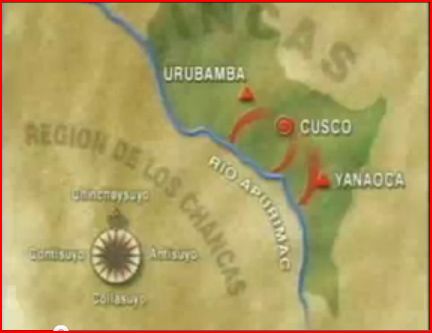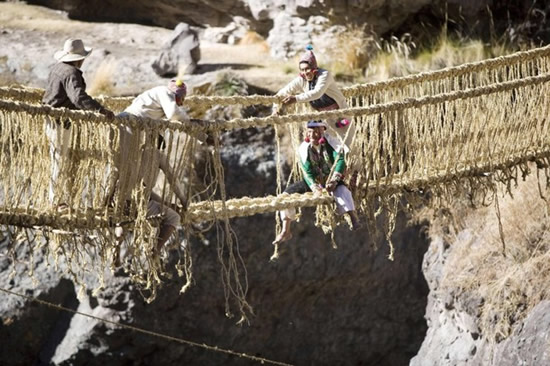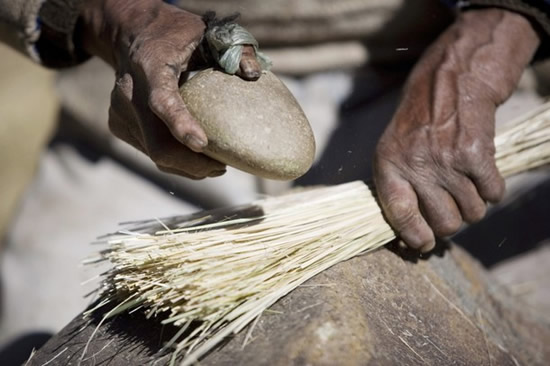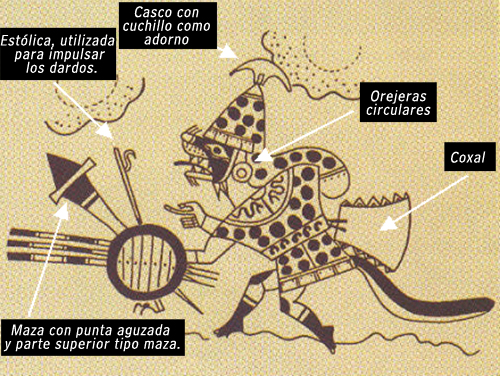It looks like you're using an Ad Blocker.
Please white-list or disable AboveTopSecret.com in your ad-blocking tool.
Thank you.
Some features of ATS will be disabled while you continue to use an ad-blocker.
share:
I've wishing to make a thread about this one for a while, today I found a good video (in english), to put together with the rest of the info. provided
by a source with beautiful pics too. Hope you like it.
When the the Inca's empire started to expand to other territories, they were stopped by the Apurimac river, which was a natural barrier between them and the Chankas territories. This is how they crossed the river.


No wood had been used to built this bridge, just grass ( ichu and/or qoya). In the video and photos you'll observe the ancient technique amazingly haven't been lost. The bridge had been restored by locals, showing respect to the ancestors.

The ropes are the wide of a man's arm and the bridge can hold 15 men crossing it at the same time.

www.odditycentral.com...
(spanish) www.youtube.com...
When the the Inca's empire started to expand to other territories, they were stopped by the Apurimac river, which was a natural barrier between them and the Chankas territories. This is how they crossed the river.

Located approximately 100 km from Cuzco, Qeswachaka bridge was once part of a network of bridges, built in the time of the Inca empire, but is now the only one of its kind, in the world. Spanning 120 feet over the Apurimac river, at around 13,000 feet above water, Qeswachaka (also spelled Q’eswachaka or Keswachaka) is built using the ancient Qhapaq nan technique, used by the Inca people.

No wood had been used to built this bridge, just grass ( ichu and/or qoya). In the video and photos you'll observe the ancient technique amazingly haven't been lost. The bridge had been restored by locals, showing respect to the ancestors.

The ropes are the wide of a man's arm and the bridge can hold 15 men crossing it at the same time.

www.odditycentral.com...
(spanish) www.youtube.com...
edit on 21-3-2012 by Trueman because: (no reason given)
Very nice, I think it shows the tensile strength of ancient rope, which they would need for moving and lifting megaliths, as well as building such
bridges.
I think it's fair to say that not all the advances of an ancient civilization or culture resulted in impervious stone megaliths to remind us of their passing, much more were probably organic and fleeting examples of weaving and rope-making and other short-lived textiles.
According to Herodotus, Xerxes made a pontoon bridge to cross the Hellespont in 480 BC, with two ropes that were allegedly seven stadia (about 1 km) long, and by our measure, two feet in diameter, but that lacked the sophistication of this Inca bridge.
I think you could also safely say that every single culture that moved megaliths also had a highly developed rope-making ability (as part of their overall textile industry) - Egyptians, Greeks, Sumerians, Persians, Romans, etc., even the ancient Britons.
I think it's fair to say that not all the advances of an ancient civilization or culture resulted in impervious stone megaliths to remind us of their passing, much more were probably organic and fleeting examples of weaving and rope-making and other short-lived textiles.
According to Herodotus, Xerxes made a pontoon bridge to cross the Hellespont in 480 BC, with two ropes that were allegedly seven stadia (about 1 km) long, and by our measure, two feet in diameter, but that lacked the sophistication of this Inca bridge.
I think you could also safely say that every single culture that moved megaliths also had a highly developed rope-making ability (as part of their overall textile industry) - Egyptians, Greeks, Sumerians, Persians, Romans, etc., even the ancient Britons.
edit on 21-3-2012 by Blackmarketeer
because: (no reason given)
edit on 21-3-2012 by Blackmarketeer because: (no reason given)
Very nice!
One word of correction here:
Nothing is "weaved"
The grass fibers are twisted then braided in to rope.
My question is how do they get the first strand across?
One word of correction here:
Nothing is "weaved"
The grass fibers are twisted then braided in to rope.
My question is how do they get the first strand across?
Originally posted by Asktheanimals
Very nice!
One word of correction here:
Nothing is "weaved"
The grass fibers are twisted then braided in to rope.
My question is how do they get the first strand across?
You shoot an arrow across pulling a light string. Then it pulls progressively larger and larger ropes across until....
Originally posted by Aliensun
Originally posted by Asktheanimals
Very nice!
One word of correction here:
Nothing is "weaved"
The grass fibers are twisted then braided in to rope.
My question is how do they get the first strand across?
You shoot n arrow across pulling a light string. Then it pulls progressively larger and larger ropes across until....
Aha! Thanks, I wouldn't have thought of that myself.
Sounds plausible to me.
Very interesting video.
I would love to see there bridge and experience the culture of the region.
But no way an i getting my big butt on a grass bridge.
I would love to see there bridge and experience the culture of the region.
But no way an i getting my big butt on a grass bridge.
Originally posted by Asktheanimals
Originally posted by Aliensun
Originally posted by Asktheanimals
Very nice!
One word of correction here:
Nothing is "weaved"
The grass fibers are twisted then braided in to rope.
My question is how do they get the first strand across?
You shoot n arrow across pulling a light string. Then it pulls progressively larger and larger ropes across until....
Aha! Thanks, I wouldn't have thought of that myself.
Sounds plausible to me.
Good question. My first thought was also the same, but didn't used bow and arrows. The long range artifact/weapon they used was the estolica, this weapon was more like a dart thrower.
Estolica - Small, flexible spear thrower to throw projectiles (similar to the Aztec atlatl) were mostly employed by the jungle troops.
en.wikipedia.org...

edit on 22-3-2012 by Trueman because: (no reason given)
A nice show of 'advanced' technology by the locals themselves
Originally posted by Hanslune
A nice show of 'advanced' technology by the locals themselves
Their technology has zero impact, total respect for Mother Earth. Can't be more advanced than that.
reply to post by Trueman
Mostly correct but by building the bridge they allow more movement which does alter the environment just slightly. In India they had to booby trap a bridge because tigers had learned to cross it.
Good information
Mostly correct but by building the bridge they allow more movement which does alter the environment just slightly. In India they had to booby trap a bridge because tigers had learned to cross it.
Good information
reply to post by Trueman
That would be the equivalent of an atl-atl, or spear thrower.
It was their lack of bows that kept me from thinking that was how it was done.
That would be the equivalent of an atl-atl, or spear thrower.
It was their lack of bows that kept me from thinking that was how it was done.
Originally posted by Hanslune
A nice show of 'advanced' technology by the locals themselves
The footage used is taken from a pbs doc. from several years ago, also in the documentary some of the same local's stone masons used traditional techniques to haul large stones from an ancient quarry to s site a build a traditional interlocking stone wall with nothing more than wood and stone tools.
It is a very very informative film.
I think there were about 1/2 dozen to a dozen guys working, and granted their stones weren't nearly as big as the megalithic sites in the area, but they only had 12 guys working on it and built a small replica wall in about a week I believe.
edit on 22-3-2012 by punkinworks10 because: grammar
reply to post by Trueman
I absolutely love these kinds of threads! Such quiet competence, all working harmoniously together. Although how they twist the grass together and produce something of such strength AND length seems baffling to me. Does anone know how often the bridge needs to be replaced?
I absolutely love these kinds of threads! Such quiet competence, all working harmoniously together. Although how they twist the grass together and produce something of such strength AND length seems baffling to me. Does anone know how often the bridge needs to be replaced?
Originally posted by aboutface
reply to post by Trueman
I absolutely love these kinds of threads! Such quiet competence, all working harmoniously together. Although how they twist the grass together and produce something of such strength AND length seems baffling to me. Does anone know how often the bridge needs to be replaced?
Glad you like it. Then you'll probably enjoy this link too, from the Qeswachaka Bridge oficial site. There are 106 photos in this album, really beautiful I may say.
www.patronatomachupicchu.org...
reply to post by Hanslune
Here brother, I think you'll find this article interesting too :
www.nytimes.com...
According to John Ochsendorf, we are talking about a really advanced technology, he was able to create an equation :
(# of cords)(cord strength)(cos twisted angle)
(72 cords)(117 lbs)(cos 45º)2 = 4200 lbs
www.chatham.edu...
Here brother, I think you'll find this article interesting too :
Dr. Ochsendorf, a specialist in early architecture and engineering, said the colonial government tried many times to erect European arch bridges across the canyons, and each attempt ended in fiasco until iron and steel were applied to bridge building. The Peruvians, knowing nothing of the arch or iron metallurgy, instead relied on what they knew best, fibers from cotton, grasses and saplings, and llama and alpaca wool.
The Inca suspension bridges achieved clear spans of at least 150 feet, probably much greater. This was a longer span than any European masonry bridges at the time. The longest Roman bridge in Spain had a maximum span between supports of 95 feet. And none of these European bridges had to stretch across deep canyons.
www.nytimes.com...
According to John Ochsendorf, we are talking about a really advanced technology, he was able to create an equation :
(# of cords)(cord strength)(cos twisted angle)
(72 cords)(117 lbs)(cos 45º)2 = 4200 lbs
www.chatham.edu...
edit on 22-3-2012 by Trueman because: (no reason given)
Originally posted by Asktheanimals
reply to post by Trueman
That would be the equivalent of an atl-atl, or spear thrower.
It was their lack of bows that kept me from thinking that was how it was done.
Yes, that is a good equivalent. I believe the first rope crossed the river with nothing more than hard work and tenacy of very skilled scouts/climbers, during the time of the year when the river was lower, probably that cost a few lifes until they were successful. I could be wrong.
Originally posted by Hanslune
reply to post by punkinworks10
I don't recall that one, remember a name or where that might be?
Hi Hans,
I think it was the very first or second of " The Secrets of the Dead" maybe from 2002-2003, but I might be wrong ,
I looked through the pbs archives but they only go back a couple seasons. And I think that the show has had a couple of incarnations, possibly on different networks.
Originally posted by punkinworks10
Originally posted by Hanslune
reply to post by punkinworks10
I don't recall that one, remember a name or where that might be?
Hi Hans,
I think it was the very first or second of " The Secrets of the Dead" maybe from 2002-2003, but I might be wrong ,
I looked through the pbs archives but they only go back a couple seasons. And I think that the show has had a couple of incarnations, possibly on different networks.
I found the link to the PBS "The secrets of the Dead" show and searched in the list of episodes, couldn't find one related to this discussion in the list. We have to thank punkinworks anyway, that show has other very interesting episodes that I will watch.
www.pbs.org...
new topics
-
BIDEN Admin Begins Planning For January 2025 Transition to a New President - Today is 4.26.2024.
2024 Elections: 28 minutes ago -
Big Storms
Fragile Earth: 1 hours ago -
Where should Trump hold his next rally
2024 Elections: 4 hours ago -
Shocking Number of Voters are Open to Committing Election Fraud
US Political Madness: 5 hours ago -
Gov Kristi Noem Shot and Killed "Less Than Worthless Dog" and a 'Smelly Goat
2024 Elections: 6 hours ago -
Falkville Robot-Man
Aliens and UFOs: 6 hours ago -
James O’Keefe: I have evidence that exposes the CIA, and it’s on camera.
Whistle Blowers and Leaked Documents: 7 hours ago -
Australian PM says the quiet part out loud - "free speech is a threat to democratic dicourse"...?!
New World Order: 7 hours ago -
Ireland VS Globalists
Social Issues and Civil Unrest: 8 hours ago -
Biden "Happy To Debate Trump"
2024 Elections: 8 hours ago
top topics
-
James O’Keefe: I have evidence that exposes the CIA, and it’s on camera.
Whistle Blowers and Leaked Documents: 7 hours ago, 13 flags -
Blast from the past: ATS Review Podcast, 2006: With All Three Amigos
Member PODcasts: 11 hours ago, 13 flags -
Australian PM says the quiet part out loud - "free speech is a threat to democratic dicourse"...?!
New World Order: 7 hours ago, 12 flags -
Biden "Happy To Debate Trump"
2024 Elections: 8 hours ago, 12 flags -
Mike Pinder The Moody Blues R.I.P.
Music: 11 hours ago, 8 flags -
What is the white pill?
Philosophy and Metaphysics: 10 hours ago, 6 flags -
Shocking Number of Voters are Open to Committing Election Fraud
US Political Madness: 5 hours ago, 6 flags -
RAAF airbase in Roswell, New Mexico is on fire
Aliens and UFOs: 9 hours ago, 5 flags -
Ireland VS Globalists
Social Issues and Civil Unrest: 8 hours ago, 5 flags -
Where should Trump hold his next rally
2024 Elections: 4 hours ago, 4 flags
active topics
-
James O’Keefe: I have evidence that exposes the CIA, and it’s on camera.
Whistle Blowers and Leaked Documents • 9 • : Unseendimension -
Krystalnacht on today's most elite Universities?
Social Issues and Civil Unrest • 13 • : TheSingleBillie -
University of Texas Instantly Shuts Down Anti Israel Protests
Education and Media • 313 • : cherokeetroy -
Las Vegas UFO Spotting Teen Traumatized by Demon Creature in Backyard
Aliens and UFOs • 18 • : TheMisguidedAngel -
Falkville Robot-Man
Aliens and UFOs • 8 • : Coelacanth55 -
"We're All Hamas" Heard at Columbia University Protests
Social Issues and Civil Unrest • 295 • : marg6043 -
Gaza Terrorists Attack US Humanitarian Pier During Construction
Middle East Issues • 90 • : Zanti Misfit -
Gov Kristi Noem Shot and Killed "Less Than Worthless Dog" and a 'Smelly Goat
2024 Elections • 39 • : Zanti Misfit -
So this is what Hamas considers 'freedom fighting' ...
War On Terrorism • 268 • : TheWoker -
BIDEN Admin Begins Planning For January 2025 Transition to a New President - Today is 4.26.2024.
2024 Elections • 2 • : NoCorruptionAllowed
